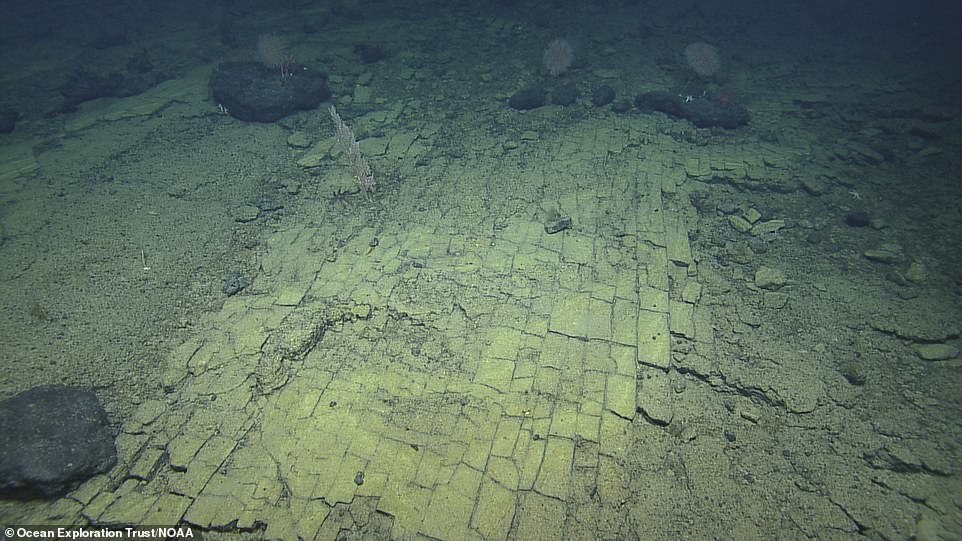
A stunning discovery has been made at the bottom of the Pacific Ocean near Hawaii Island of what looks like a paved road. Some are speculating it could be the mythical place of Atlantis while others are saying its simply a natural rock formation.
Judging by the way it looks this is most likely man-made, definitely not a natural rock formation.
How did it get under water? It’s actually not the first underwater city…
There are others in the world and while scientists are baffled, the Bible says that these are antediluvian cities, from before Noah’s flood.
Back then there was less water on Earth as most of the water was underground and in the skies. We cannot know for sure that this is a man-made road though. Maybe it is natural rock formation but what we want to say is that the version of being man-made shouldn’t be excluded as there are already many many many other cities underwater.
Here’s a report about this from the DailyMail:
It may look similar to the yellow brick road in The Wizard of Oz, or perhaps a hidden path to the mythical lost city of Atlantis.
But deep-sea researchers who spotted the incredible rock formation say it is actually an example of ancient active volcanic geology on the ocean floor near Hawaii.
The strange-looking feature, which resembles a road paved in cobblestones, was located in the Liliʻuokalani Ridge in the Papahānaumokuakea Marine National Monument (PMNM) in the Pacific Ocean.
PMNM is one of the largest marine conservation areas in the world – bigger than all the national parks in the US combined – and researchers have only explored about three per cent of its sea floor.
The crew of Exploration Vessel Nautilus research ship caught sight of the formation and described it as a ‘yellow brick road’ and ‘the road to Atlantis’ in a video of the discovery.
‘It’s the road to Atlantis,’ a researcher on the radio can be heard saying.
‘The yellow brick road?’ another adds, while a separate member team member calls it ‘bizarre’ and ‘crazy’.
The team said: ‘What may look like a “yellow brick road” to the mythical city of Atlantis is really an example of ancient active volcanic geology!
‘Our Corps of Exploration have witnessed incredibly unique and fascinating geological formations while diving on the Lili*uokalani Ridge within Papah*naumokuakea Marine National Monument.’
Nautilus spent most of April studying the geology and biological systems of ‘seamounts’ – underwater mountains with volcanic origins.
The team added in a statement: ‘At the summit of Nootka Seamount, the team spotted a “dried lake bed” formation, now IDed as a fractured flow of hyaloclastite rock (a volcanic rock formed in high-energy eruptions where many rock fragments settle to the seabed).
‘The unique 90-degree fractures are likely related to heating and cooling stress from multiple eruptions at this baked margin.
‘Throughout the seamount chain, the team also sampled basalts coated with ferromanganese (iron-manganese) crusts from across different depths and oxygen saturations as well as an interesting-looking pumice rock that almost resembled a sponge.’
The exploration vessel is operated by the non-profit Ocean Exploration Trust, which livestreams what its remote-operated diving vehicles see in the deep.
The bizarre rock formation was spotted during Ocean Exploration Trust’s Expedition NA138 to explore the Papah*naumoku*kea Marine National Monument (PMNM), in partnership with the NOAA Ocean Exploration and the Office of National Marine Sanctuaries.
Nautilus has recorded all sorts of unusual sea life, including dumbo octopuses and ‘piglet squids’.
The team said the primary objective of their latest expedition was to gather samples to determine the geologic origin and age of seamounts to gain a better understanding of the formation of the northwestern Hawaiian Islands.
They added that the seamounts would also be surveyed for biodiversity, in the hope of finding rich coral and sponge communities commonly found at these depths.
‘Considering the presumed Cretaceous age of the Liliʻuokalani Ridge seamounts, it is expected that relatively thick ferromanganese crusts have formed on exposed rock surfaces, particularly on the flanks of the seamounts where sedimentation is minimised,’ they added.
An E/V Nautilus spokesperson said: ‘Our exploration of this never-before-surveyed area is helping researchers take a deeper look at life on and within the rocky slopes of these deep, ancient seamounts.
‘These studies will help provide baseline information on the living communities of seamounts which can inform management and conservation measures.’
RELATED ARTICLES
- Swedish study says Children who catch a Cold without Vaccines develop Natural Immunity
- 100% Vaccinated Cruise Ship Hit with COVID-19 Outbreak
- Countries with Older Populations Have the Most Coronavirus Deaths
- Stanford study: COVID-19 much more widespread than thought, and NO MORE DEADLY THAN FLU
- American Nurse Describes Brutal Coronavirus Symptoms: 'Nothing Like I Expected'











